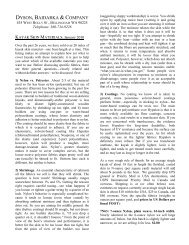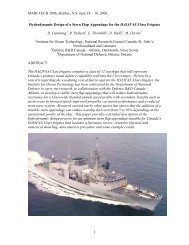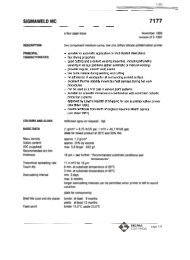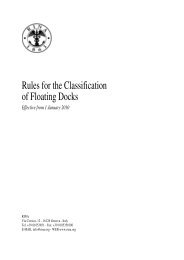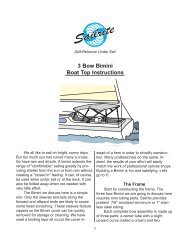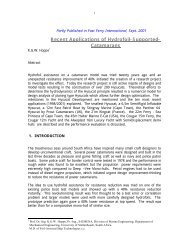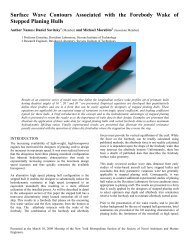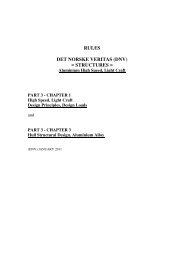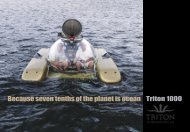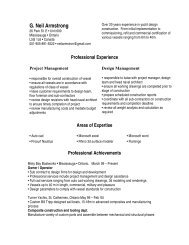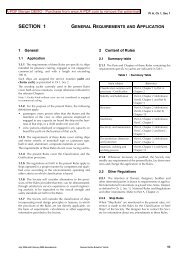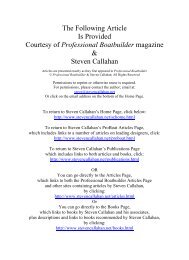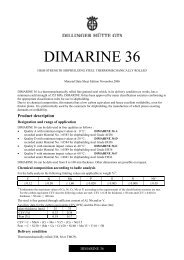Armin Troesch: Dynamics and hydrodynamics of high speed craft - PASI
Armin Troesch: Dynamics and hydrodynamics of high speed craft - PASI
Armin Troesch: Dynamics and hydrodynamics of high speed craft - PASI
You also want an ePaper? Increase the reach of your titles
YUMPU automatically turns print PDFs into web optimized ePapers that Google loves.
<strong>PASI</strong> 2010 in <strong>Dynamics</strong> <strong>and</strong> Control <strong>of</strong> Manned <strong>and</strong> UnmannedMarine Vehicles<strong>Dynamics</strong> <strong>and</strong> Hydrodynamics <strong>of</strong> High Speed Craft1400-1545, June 29, 2010Barranquilla, Colombia<strong>Armin</strong> <strong>Troesch</strong>Naval Architecture <strong>and</strong> Marine EngineeringUniversity <strong>of</strong> Michigan<strong>Armin</strong> <strong>Troesch</strong>University <strong>of</strong> MichiganDepartment <strong>of</strong> Naval Architecture <strong>and</strong> Marine Engineering<strong>Dynamics</strong> <strong>and</strong> Hydrodynamics <strong>of</strong> High Speed CraftJune 29, 2010Barranquilla, Colombia
OUTLINE• Planing Hull Hydrodynamics <strong>and</strong> <strong>Dynamics</strong>Selected experiments <strong>and</strong> theorieswith practical applications• Nonlinear <strong>Dynamics</strong> Analysis Applied to Planing Hulls• Stochastic Vibro-Impact Model for Extreme PlaningCraft Acceleration Estimation<strong>Armin</strong> <strong>Troesch</strong>University <strong>of</strong> MichiganDepartment <strong>of</strong> Naval Architecture <strong>and</strong> Marine Engineering<strong>Dynamics</strong> <strong>and</strong> Hydrodynamics <strong>of</strong> High Speed CraftJune 29, 2010Barranquilla, Colombia
With a little help from friends:Recently Active UM Graduates:Dr. Lixin XuDr. Carolyn Frank JudgeWayne Arguin (USCG)Timothy Conners (USCG)Dr. Richard RoyceTony DanielsDr. Kevin MakiDr. Brant Sav<strong>and</strong>erOscar Tuscan (Dr. to-be)Fredy ZarateAnd many more…….<strong>Armin</strong> <strong>Troesch</strong>University <strong>of</strong> MichiganDepartment <strong>of</strong> Naval Architecture <strong>and</strong> Marine Engineering<strong>Dynamics</strong> <strong>and</strong> Hydrodynamics <strong>of</strong> High Speed CraftJune 29, 2010Barranquilla, Colombia
Planing <strong>and</strong> Impact Research at UMKang, K.G. (1988) Non-linear Impact Hydrodynamics. Ph.D. Thesis.Talmor, A. (1991) Non-linear Slender-Body Approach for Predicting Planing Performance, Ph.D. Thesis.Hicks, J.D. (1993) Analysis Method for Planing Hull Vertical Motions. Pr<strong>of</strong>essional Degree Thesis.Lai, C. (1994) Hydrodynamic <strong>and</strong> Dynamic Analysis <strong>of</strong> High Speed Planing, Ph.D. Thesis.Akers, R.H. (1995) Planing Hull Design Environment. Pr<strong>of</strong>essional Degree Thesis.Wang, M. (1995) A Study on Non-linear Free Surface Flows. Ph.D. Thesis.Sav<strong>and</strong>er, B.R. (1997) Planing Hull Steady Hydrodynamics. Ph.D. Thesis.Xu, L. (1998) A Theory for Asymmetric Vessel Impact <strong>and</strong> Steady Planing. Ph.D. Thesis.Judge, C.F. (2000) Impact <strong>of</strong> Wedges with Horizontal <strong>and</strong> Vertical Velocities. Ph.D. Thesis.Arguin, W. (2001) Simulation <strong>of</strong> Planing Hull <strong>Dynamics</strong> in the Transverse Plane. MSE Thesis.Conners, T. (2001) Coupled Surge, Sway, Roll, <strong>and</strong> Yaw Hydrodynamic Coefficients for High Speed Planing Craft.MSE Thesis.Royce, R.A. (2001) Impact Theory Extended to Planing Craft with Experimental Comparisons. Ph.D. Thesis.Daniels, A.S. (2002) Design <strong>and</strong> Construction <strong>of</strong> the Stepped Planing Hull Dynamometer. Pr<strong>of</strong>essional Degree Thesis.Maki, K. (2005) Transom Stern Hydrodynamics, Ph.D. Thesis.Tascon, O. (2010) Numerical Computation <strong>of</strong> the Hydrodynamic Forces Acting on a Maneuvering Planing Hull via Slender BodyTheory - SBT <strong>and</strong> 2-D CFD Impact Theory. Ph.D. ThesisRose, C. J. (2010) Marine Systems Application <strong>of</strong> Extreme Value Prediction <strong>of</strong> a Vibro-Impact System Subject to StochasticExcitation, MSE ThesisZarate, F. (2010) CFD Modeling <strong>of</strong> Yawed <strong>and</strong> Heeled High Speed Planing Hulls, MSE Thesis<strong>Armin</strong> <strong>Troesch</strong>University <strong>of</strong> MichiganDepartment <strong>of</strong> Naval Architecture <strong>and</strong> Marine Engineering<strong>Dynamics</strong> <strong>and</strong> Hydrodynamics <strong>of</strong> High Speed CraftJune 29, 2010Barranquilla, Colombia
Planing Craft Resistance <strong>and</strong> <strong>Dynamics</strong><strong>Armin</strong> <strong>Troesch</strong>University <strong>of</strong> MichiganDepartment <strong>of</strong> Naval Architecture <strong>and</strong> Marine Engineering<strong>Dynamics</strong> <strong>and</strong> Hydrodynamics <strong>of</strong> High Speed CraftJune 29, 2010Barranquilla, Colombia
Planing Craft Resistance <strong>and</strong> <strong>Dynamics</strong>Steps<strong>Armin</strong> <strong>Troesch</strong>University <strong>of</strong> MichiganDepartment <strong>of</strong> Naval Architecture <strong>and</strong> Marine Engineering<strong>Dynamics</strong> <strong>and</strong> Hydrodynamics <strong>of</strong> High Speed CraftJune 29, 2010Barranquilla, Colombia
Planing Hull DesigngivenHull Particulars (target)Propulsion CharacteristicsEnvironment?AnalysisSteadyPerformance?UnsteadyPerformancePrototype<strong>Armin</strong> <strong>Troesch</strong>University <strong>of</strong> MichiganDepartment <strong>of</strong> Naval Architecture <strong>and</strong> Marine Engineering<strong>Dynamics</strong> <strong>and</strong> Hydrodynamics <strong>of</strong> High Speed CraftJune 29, 2010Barranquilla, Colombia
Physics <strong>of</strong> Planing - Some DefinitionsJetJet headCalmwaterlineJetedgeWetted chineDry chine<strong>Armin</strong> <strong>Troesch</strong>University <strong>of</strong> MichiganDepartment <strong>of</strong> Naval Architecture <strong>and</strong> Marine Engineering<strong>Dynamics</strong> <strong>and</strong> Hydrodynamics <strong>of</strong> High Speed CraftJune 29, 2010Barranquilla, Colombia
Physics <strong>of</strong> Planing - Some definitions <strong>and</strong> idealizationsSlender, low aspect ratio, prismatic hulls:Wagner (1931, 1932), von Karman (1929)<strong>Armin</strong> <strong>Troesch</strong>University <strong>of</strong> MichiganDepartment <strong>of</strong> Naval Architecture <strong>and</strong> Marine Engineering<strong>Dynamics</strong> <strong>and</strong> Hydrodynamics <strong>of</strong> High Speed CraftJune 29, 2010Barranquilla, Colombia
Physics <strong>of</strong> Planing - Some definitions <strong>and</strong> idealizationsHigh aspect ratio, flat hulls:Green (1936)<strong>Armin</strong> <strong>Troesch</strong>University <strong>of</strong> MichiganDepartment <strong>of</strong> Naval Architecture <strong>and</strong> Marine Engineering<strong>Dynamics</strong> <strong>and</strong> Hydrodynamics <strong>of</strong> High Speed CraftJune 29, 2010Barranquilla, Colombia
Physics <strong>of</strong> Planing - Some definitions <strong>and</strong> idealizationsSlender, low aspect ratio, flat hulls:Tulin (1957)<strong>Armin</strong> <strong>Troesch</strong>University <strong>of</strong> MichiganDepartment <strong>of</strong> Naval Architecture <strong>and</strong> Marine Engineering<strong>Dynamics</strong> <strong>and</strong> Hydrodynamics <strong>of</strong> High Speed CraftJune 29, 2010Barranquilla, Colombia
Physics <strong>of</strong> Planing - Force <strong>and</strong> moment balanceRef: Experiments <strong>of</strong> prismatic planing hulls, Savitsky (1964)<strong>Armin</strong> <strong>Troesch</strong>University <strong>of</strong> MichiganDepartment <strong>of</strong> Naval Architecture <strong>and</strong> Marine Engineering<strong>Dynamics</strong> <strong>and</strong> Hydrodynamics <strong>of</strong> High Speed CraftJune 29, 2010Barranquilla, Colombia
Relationship between planing<strong>and</strong> impact <strong>hydrodynamics</strong>• Low order approximation• Coordinate transformation betweentime <strong>and</strong> longitudinal coordinateX = U t• Transverse plane is equivalent to 2-Dimpact or strip theory approximation <strong>of</strong>planing<strong>Armin</strong> <strong>Troesch</strong>University <strong>of</strong> MichiganDepartment <strong>of</strong> Naval Architecture <strong>and</strong> Marine Engineering<strong>Dynamics</strong> <strong>and</strong> Hydrodynamics <strong>of</strong> High Speed CraftJune 29, 2010Barranquilla, Colombia
Seminal Work in Impact Hydrodynamics, Wagner (1932) Model:<strong>Armin</strong> <strong>Troesch</strong>University <strong>of</strong> MichiganDepartment <strong>of</strong> Naval Architecture <strong>and</strong> Marine Engineering<strong>Dynamics</strong> <strong>and</strong> Hydrodynamics <strong>of</strong> High Speed CraftJune 29, 2010Barranquilla, Colombia
Reduction <strong>of</strong> physical model to 2-D impactsolution spaceyZ ch( x)Hull Cross Section Geometryβ( xz , )hxz ( , ) h o( xz , )y wl( x)zyFlow Physicsvwz c( x )v n( z)C p( z)v s( z)v jetv s( z)y wl( x) zV( x)z b( x)ApproximationPlaning surface passing through earth-fixed planev=∂φ∂yw=∂φ∂zyv n body ,=v n fluid ,C p( z) = 0vz ( )zSlender Body Theory Planing Model, Sav<strong>and</strong>er, et al. (2002)γ( z) = 2w( z) ≠ 0γ = w = 0<strong>Armin</strong> <strong>Troesch</strong>University <strong>of</strong> MichiganDepartment <strong>of</strong> Naval Architecture <strong>and</strong> Marine Engineering<strong>Dynamics</strong> <strong>and</strong> Hydrodynamics <strong>of</strong> High Speed CraftJune 29, 2010Barranquilla, Colombia
The Boundary Value Problem• Nonlinear dynamic free surface boundary condition( V s − z cτ ζ) ∂V s∂ζ + z dV scdτ = 0• Body kinematic boundary conditionγ c ( ζ, τ) =−2cosβ ( ζ,τ)ζκ ( ζ, τ )⎡⎢1 −ζ 2 ⎢ V()+ τ1⎢ π⎣+ ζ2 −1πb( τ)∫s=1γ s ( s,τ)dsκ( s, τ) s 2 −11≤ζ≤b()τb( τ)∫s=1( )( s 2 −ζ 2 )γ s ( s,τ)ds( )κ( s, τ) s 2 − 1⎤⎥⎥⎥⎦+0 ≤ z ≤ z c ( τ)<strong>Armin</strong> <strong>Troesch</strong>University <strong>of</strong> MichiganDepartment <strong>of</strong> Naval Architecture <strong>and</strong> Marine Engineering<strong>Dynamics</strong> <strong>and</strong> Hydrodynamics <strong>of</strong> High Speed CraftJune 29, 2010Barranquilla, Colombia
The Boundary Value Problem, con’t.• Velocity continuity condition (i.e. Kutta condition)V()+ τ1 πbγ s ( s,τ)ds∫ at z = zc(z = 1)s=1 κ( s, τ) s 2 = 0−1( )Total Pressure Coefficient• Displacement continuity condition9.08.0Y wl ( τ)= 2 π1∫s=0cos β ( s,τ)h c ( s, τ)dsκ( s, τ) 1 − s 20.8y/Z ch 0.60.40.20-1-0.500.51-1.00.01.02.03.04.0Y6.05.0x/Z chXZ7.0C p0.0500.0450.0400.0350.0300.0250.0200.0150.0100.0050.000z/Z ch<strong>Armin</strong> <strong>Troesch</strong>University <strong>of</strong> MichiganDepartment <strong>of</strong> Naval Architecture <strong>and</strong> Marine Engineering<strong>Dynamics</strong> <strong>and</strong> Hydrodynamics <strong>of</strong> High Speed CraftJune 29, 2010Barranquilla, Colombia
3-D Pressure Distribution <strong>and</strong> Spray SheetBrown&Martin Vorus&Lai Usaero z=0Spray RootKeelC L (Savitsky) 0.091C L (USAERO) 0.053oθ 0 (z=0) 23.29oθ (USAERO) 29.17oθ (Vorus&Lai) 32.88oθ (Brown&Martin) 39.47λ = 0.913, τ = 9 , β = 20ooVariable deadrise 40 mph skiboatCalculations based on 3-Dboundary integral method(Sav<strong>and</strong>er, 1997)<strong>Armin</strong> <strong>Troesch</strong>University <strong>of</strong> MichiganDepartment <strong>of</strong> Naval Architecture <strong>and</strong> Marine Engineering<strong>Dynamics</strong> <strong>and</strong> Hydrodynamics <strong>of</strong> High Speed CraftJune 29, 2010Barranquilla, Colombia
FLUENT 6.1 (CFD) Analysis: Straight Line RunningBass BoatDown Angle Lifting Strake IncludedFLUENT 6.02d, Segregated, VOFLam, Unsteady30Time = 0.150 secU=50mphτ =1.74degx=11.0ft25Transverse Flow @ Transom:50 mphEngine Trim ¼ OutStraight Liney(inches)20151050-50 5 10 15 20 25 30 35 40 45 50x (inches)Starboard Transom <strong>of</strong> Bass BoatSection Bottom Pressure Comparison1.51.0Ideal FlowSolutionPressure(psI)0.5β = 12 deg0.0FLUENT-0.50 5 10 15 20 25 30 35 40 45 50x (inches)<strong>Armin</strong> <strong>Troesch</strong>University <strong>of</strong> MichiganDepartment <strong>of</strong> Naval Architecture <strong>and</strong> Marine Engineering<strong>Dynamics</strong> <strong>and</strong> Hydrodynamics <strong>of</strong> High Speed CraftJune 29, 2010Barranquilla, Colombia
Conclusions <strong>of</strong> planing modeling analysis(the more significant ones?)• Modeling the jet separation point (line) is critical toaccurate planing predictions.• Prediction <strong>of</strong> the correct wetted surface is critical toaccurate planing predictions.• There may be significant non-slender effects for large θ.• The reduction to the z=0 plane works well in the chinesdry regime but less so in the chines wet regime.• Both slender body theory <strong>and</strong> 3-D Models have thepotential to predict steady lift <strong>and</strong> drag accuratelyenough for design purposes.<strong>Armin</strong> <strong>Troesch</strong>University <strong>of</strong> MichiganDepartment <strong>of</strong> Naval Architecture <strong>and</strong> Marine Engineering<strong>Dynamics</strong> <strong>and</strong> Hydrodynamics <strong>of</strong> High Speed CraftJune 29, 2010Barranquilla, Colombia
Validation <strong>and</strong> Application <strong>of</strong> TechnologyExtension <strong>of</strong> 2-D Planing Theory to Innovative Hull Form Design(a) High pressure region in chines dry impact(b) Low pressure region in chines wet impactCalculated variation <strong>of</strong> deadrise to achieve maximum lift to drag ratioPlan View<strong>high</strong> pressurelow pressure<strong>Armin</strong> <strong>Troesch</strong>University <strong>of</strong> MichiganDepartment <strong>of</strong> Naval Architecture <strong>and</strong> Marine Engineering<strong>Dynamics</strong> <strong>and</strong> Hydrodynamics <strong>of</strong> High Speed CraftJune 29, 2010Barranquilla, Colombia
Validation <strong>and</strong> Application <strong>of</strong> TechnologySOLAR SPLASH: Intercollegiate Solar/Electric Boat Regatta featuringThe University <strong>of</strong> Michigan’s Inverted “V” Planing Hull<strong>Armin</strong> <strong>Troesch</strong>University <strong>of</strong> MichiganDepartment <strong>of</strong> Naval Architecture <strong>and</strong> Marine Engineering<strong>Dynamics</strong> <strong>and</strong> Hydrodynamics <strong>of</strong> High Speed CraftJune 29, 2010Barranquilla, Colombia
OUTLINE• Planing Hull Hydrodynamics <strong>and</strong> <strong>Dynamics</strong>Selected experiments <strong>and</strong> theorieswith practical applications• Nonlinear <strong>Dynamics</strong> Analysis Applied to Planing Hulls• Stochastic Vibro-Impact Model for Extreme PlaningCraft Acceleration Estimation<strong>Armin</strong> <strong>Troesch</strong>University <strong>of</strong> MichiganDepartment <strong>of</strong> Naval Architecture <strong>and</strong> Marine Engineering<strong>Dynamics</strong> <strong>and</strong> Hydrodynamics <strong>of</strong> High Speed CraftJune 29, 2010Barranquilla, Colombia
RATIONALE FOR DYNAMIC ANALYSIS:Identification <strong>of</strong> design parameters that arecritical to performance.TitleExample: “A Case Study <strong>of</strong> Dynamic Instability in aPlaning Hull”, Codega <strong>and</strong> Lewis. Marine Tech., April,1987<strong>Armin</strong> <strong>Troesch</strong>University <strong>of</strong> MichiganDepartment <strong>of</strong> Naval Architecture <strong>and</strong> Marine Engineering<strong>Dynamics</strong> <strong>and</strong> Hydrodynamics <strong>of</strong> High Speed CraftJune 29, 2010Barranquilla, Colombia
Problem Definition : Steady Symmetric Planingattached chines drypressure distributionseparated chines wet<strong>Armin</strong> <strong>Troesch</strong>University <strong>of</strong> MichiganDepartment <strong>of</strong> Naval Architecture <strong>and</strong> Marine Engineering<strong>Dynamics</strong> <strong>and</strong> Hydrodynamics <strong>of</strong> High Speed CraftJune 29, 2010Barranquilla, Colombia
Problem Definition : Steady Asymmetric Planing -Type “A”attached chines dryseparated chines dry/wet<strong>Armin</strong> <strong>Troesch</strong>University <strong>of</strong> MichiganDepartment <strong>of</strong> Naval Architecture <strong>and</strong> Marine Engineering<strong>Dynamics</strong> <strong>and</strong> Hydrodynamics <strong>of</strong> High Speed CraftJune 29, 2010Barranquilla, Colombia
Problem Definition : Steady Asymmetric Planing -Type “B”keel separation/attached keel separation/chines dry<strong>Armin</strong> <strong>Troesch</strong>University <strong>of</strong> MichiganDepartment <strong>of</strong> Naval Architecture <strong>and</strong> Marine Engineering<strong>Dynamics</strong> <strong>and</strong> Hydrodynamics <strong>of</strong> High Speed CraftJune 29, 2010Barranquilla, Colombia
Transition to Steady Asymmetric Planing -Type “B”<strong>Armin</strong> <strong>Troesch</strong>University <strong>of</strong> MichiganDepartment <strong>of</strong> Naval Architecture <strong>and</strong> Marine Engineering<strong>Dynamics</strong> <strong>and</strong> Hydrodynamics <strong>of</strong> High Speed CraftJune 29, 2010Barranquilla, Colombia
Steady Transverse Planing Modeling:Asymmetric Impact TheoryU ( t)≡ V2DW ( t)≡ W2D( x)( x)Type B (U/W = 0.4)Type A (U/W = 0.4)Critical angle β2 versus the corresponding β1 at whichventilation occurs <strong>of</strong>f the keel for different ratios <strong>of</strong> impactvelocities(Judge et al, 1999Xu et al, 1998, 1999)<strong>Armin</strong> <strong>Troesch</strong>University <strong>of</strong> MichiganDepartment <strong>of</strong> Naval Architecture <strong>and</strong> Marine Engineering<strong>Dynamics</strong> <strong>and</strong> Hydrodynamics <strong>of</strong> High Speed CraftJune 29, 2010Barranquilla, Colombia
Steady Transition to asymmetric planing - Type “B”35 deg deadrise heeled 20 deg 35 deg deadrise heeled 29 deg<strong>Armin</strong> <strong>Troesch</strong>University <strong>of</strong> MichiganDepartment <strong>of</strong> Naval Architecture <strong>and</strong> Marine Engineering<strong>Dynamics</strong> <strong>and</strong> Hydrodynamics <strong>of</strong> High Speed CraftJune 29, 2010Barranquilla, Colombia
Jet RootKeelJet RootJet RootKeelJet RootV/U = 0.52V/U = 1.30V/U = 2.08Jet RootKeelJet RootOnset <strong>of</strong> SeparationDue to TransverseVelocityDirection <strong>of</strong> V<strong>Armin</strong> <strong>Troesch</strong>University <strong>of</strong> MichiganDepartment <strong>of</strong> Naval Architecture <strong>and</strong> Marine Engineering<strong>Dynamics</strong> <strong>and</strong> Hydrodynamics <strong>of</strong> High Speed CraftJune 29, 2010Barranquilla, Colombia
Steady Asymmetric planing due to horizontalvelocityWEstimate <strong>of</strong> the horizontal velocityrequired for separation:VVW ≅ V jV jβ j β 1W sinβ j− tanβ 1cosβ jtanβ 1β 1 V/W20 o 4.2-4.535 o 2.0-2.5Ref: Xu, <strong>Troesch</strong>, 1999 <strong>and</strong> Judge, et al. 2002<strong>Armin</strong> <strong>Troesch</strong>University <strong>of</strong> MichiganDepartment <strong>of</strong> Naval Architecture <strong>and</strong> Marine Engineering<strong>Dynamics</strong> <strong>and</strong> Hydrodynamics <strong>of</strong> High Speed CraftJune 29, 2010Barranquilla, Colombia
The Synergy <strong>of</strong> Experiments<strong>and</strong> TheoryExperiments with prismatic hull forms• Steady planing• Unsteady planing - vertical planemotionsFor example: Savitsky (1964), Altman (1968),Fridsma (1969, 1971), De Zwaan (1976), Savitsky &Brown (1976), <strong>Troesch</strong> (1992), <strong>and</strong> others…….<strong>Armin</strong> <strong>Troesch</strong>University <strong>of</strong> MichiganDepartment <strong>of</strong> Naval Architecture <strong>and</strong> Marine Engineering<strong>Dynamics</strong> <strong>and</strong> Hydrodynamics <strong>of</strong> High Speed CraftJune 29, 2010Barranquilla, Colombia
On the Hydrodynamics <strong>of</strong> VerticallyOscillating Planing Hulls<strong>Armin</strong> <strong>Troesch</strong>University <strong>of</strong> MichiganDepartment <strong>of</strong> Naval Architecture <strong>and</strong> Marine Engineering<strong>Dynamics</strong> <strong>and</strong> Hydrodynamics <strong>of</strong> High Speed CraftJune 29, 2010Barranquilla, Colombia
Z = m ˙ ˙ η 3 (t)M = I 55 ˙ ˙ η 5 (t)May be Modeled as[ m + A(η;ω) ]{ ˙ η (t)}+ B(η;ω)[ ] ˙[ ] η(t){ η (t)}+ C(η) { }= { F(t) }<strong>Armin</strong> <strong>Troesch</strong>University <strong>of</strong> MichiganDepartment <strong>of</strong> Naval Architecture <strong>and</strong> Marine Engineering<strong>Dynamics</strong> <strong>and</strong> Hydrodynamics <strong>of</strong> High Speed CraftJune 29, 2010Barranquilla, Colombia
Geometry: Dynamic wetted lengthL(t) = lcg +( ) − ( z wl +η 3 (t))sin( τ−η 5 (t))vcgtan τ−η 5 (t)λ ave = ( λ k +λ c ) 2 + 0.03λ ˆk = λ ˆave + 0.5( 0.57 + 0.001β) ( tan β (2 tan(τ−η 5 )) − 0.006β)− 0.03λ ˆc = λ ˆk − ( 0.57 + 0.001β )( tanβ (2tan(τ−η 5 )) − 0.006β) for λ ˆc ≥ 1Steady mean wetted length from Savitsky (1964)<strong>and</strong> Savitsky &Brown (1976) modified for motions (<strong>Troesch</strong> 1992)<strong>Armin</strong> <strong>Troesch</strong>University <strong>of</strong> MichiganDepartment <strong>of</strong> Naval Architecture <strong>and</strong> Marine Engineering<strong>Dynamics</strong> <strong>and</strong> Hydrodynamics <strong>of</strong> High Speed CraftJune 29, 2010Barranquilla, Colombia
Geometry: Dynamic wetted length in heaveWetted keelWetted chineTop <strong>of</strong> strokeWetted keelBottom <strong>of</strong> stroke<strong>Armin</strong> <strong>Troesch</strong>University <strong>of</strong> MichiganDepartment <strong>of</strong> Naval Architecture <strong>and</strong> Marine Engineering<strong>Dynamics</strong> <strong>and</strong> Hydrodynamics <strong>of</strong> High Speed CraftJune 29, 2010Barranquilla, Colombia
Geometry: Dynamic wetted length in heaveTop <strong>of</strong> strokeBottom <strong>of</strong> stroke<strong>Armin</strong> <strong>Troesch</strong>University <strong>of</strong> MichiganDepartment <strong>of</strong> Naval Architecture <strong>and</strong> Marine Engineering<strong>Dynamics</strong> <strong>and</strong> Hydrodynamics <strong>of</strong> High Speed CraftJune 29, 2010Barranquilla, Colombia
Geometry: Dynamic wetted lengthWetted length6Forced static heave Forced static pitch5x 4x3xx2 xx 1x0-0.15 -0.1 -0.05 0 0.05 0.1 0.15η 3 BWetted length6543 xx xxx xx2-2 -1 0 1 2η 5 (deg)Wetted length versus constant heave <strong>and</strong> pitch displacement. -■-, λave;- - - , Eq. (5); -●-, λk; ––, Eq. (6); -✕-, λc ; - - -, Eq. (7).<strong>Armin</strong> <strong>Troesch</strong>University <strong>of</strong> MichiganDepartment <strong>of</strong> Naval Architecture <strong>and</strong> Marine Engineering<strong>Dynamics</strong> <strong>and</strong> Hydrodynamics <strong>of</strong> High Speed CraftJune 29, 2010Barranquilla, Colombia
Geometry Dynamic wetted lengthForced heave Forced pitchWetted lengthWetted length2π tT2π tTWetted length during one cycle <strong>of</strong> heave <strong>and</strong> pitch oscillation.ξ 3 /B = 0.036, ω Bg= 1.13. + , λ c ; - - -, Eq. (4); ● , λ k ; ––, Eq. (4).<strong>Armin</strong> <strong>Troesch</strong>University <strong>of</strong> MichiganDepartment <strong>of</strong> Naval Architecture <strong>and</strong> Marine Engineering<strong>Dynamics</strong> <strong>and</strong> Hydrodynamics <strong>of</strong> High Speed CraftJune 29, 2010Barranquilla, Colombia
Geometry: Dynamic wetted lengthForced heave46Chine Wetted length321 xxxxx xx0 0.05 0.1 0.15ζ 3 BKeel Wetted length5432 xxxxx xx0 0.05 0.1 0.15ζ 3 BWetted maximum <strong>and</strong> minimum chine <strong>and</strong> keel lengths as a function <strong>of</strong>heave amplitude. -●- , λ max; ––, Eq. (4); -✕-, λ min; - - -, Eq. (4); -■-,λave<strong>Armin</strong> <strong>Troesch</strong>University <strong>of</strong> MichiganDepartment <strong>of</strong> Naval Architecture <strong>and</strong> Marine Engineering<strong>Dynamics</strong> <strong>and</strong> Hydrodynamics <strong>of</strong> High Speed CraftJune 29, 2010Barranquilla, Colombia
Geometry: Dynamic wetted lengthForced pitch47Chine Wetted length3.532.52x xxx x xxxxxKeel Wetted length6543xxx x xx x x1.50 0.5 1 1.5 2 2.5ζ 5 (deg)20 0.5 1 1.5 2 2.5ζ 5 (deg)Wetted maximum <strong>and</strong> minimum chine <strong>and</strong> keel lengths as a function <strong>of</strong>pitch amplitude. -●- , λ max; ––, Eq. (4); -✕-, λ min; - - -, Eq. (4); -■-,λave .<strong>Armin</strong> <strong>Troesch</strong>University <strong>of</strong> MichiganDepartment <strong>of</strong> Naval Architecture <strong>and</strong> Marine Engineering<strong>Dynamics</strong> <strong>and</strong> Hydrodynamics <strong>of</strong> High Speed CraftJune 29, 2010Barranquilla, Colombia
Hydrodynamic stiffness, C 55 <strong>and</strong> C 33Forced pitch Forced heave0.10.4F 5 ρ V 2 B 30.05 ◆◆◆◆-0.050 ▲ ▲ ▲ ▲◆◆▲ ▲▲ ◆-0.1-2.5 -2 -1.5 -1 -0.5 0 0.5 1 1.5 2 2.5η 5 (deg)F 3 ρ V 2 B 20.3◆0.2◆◆▲0.1▲ ◆▲▲ ◆▲▲◆◆ ▲0-0.2 -0.15 -0.1 -0.05 0 0.05 0.1 0.15η 3 B: Total vertical force <strong>and</strong> moment versus constant linear heave <strong>and</strong> pitchdisplacement. L/B = 3.0 , τ = 4.0 deg. Cv = 1.5; -◆-, exp; ––; Savitsky[14]. Cv = 2.5; -▲-, exp; - - -, Savitsky [14].<strong>Armin</strong> <strong>Troesch</strong>University <strong>of</strong> MichiganDepartment <strong>of</strong> Naval Architecture <strong>and</strong> Marine Engineering<strong>Dynamics</strong> <strong>and</strong> Hydrodynamics <strong>of</strong> High Speed CraftJune 29, 2010Barranquilla, Colombia
Hydrodynamic stiffness, C 35 <strong>and</strong> C 53Forced pitch Forced heaveF 3 ρ V 2 B 20.140.120.10.080.060.04◆▲◆▲◆▲◆▲◆▲◆▲◆▲F 5 ρ V 2 B 30.050-0.05-0.1-0.15-0.2▲◆▲◆◆▲◆▲◆▲◆▲◆ ▲0.02-2.5 -2 -1.5 -1 -0.5 0 0.5 1 1.5 2 2.5η 5 (deg)-0.25-0.2 -0.15 -0.1 -0.05 0 0.05 0.1 0.15η 3 B: Total vertical force <strong>and</strong> moment versus constant linear heave <strong>and</strong> pitchdisplacement. L/B = 3.0 , τ = 4.0 deg. Cv = 1.5; -◆-, exp; ––; Savitsky[14]. Cv = 2.5; -▲-, exp; - - -, Savitsky [14].<strong>Armin</strong> <strong>Troesch</strong>University <strong>of</strong> MichiganDepartment <strong>of</strong> Naval Architecture <strong>and</strong> Marine Engineering<strong>Dynamics</strong> <strong>and</strong> Hydrodynamics <strong>of</strong> High Speed CraftJune 29, 2010Barranquilla, Colombia
Added mass <strong>and</strong> damping, A 33 <strong>and</strong> B 33−ω 2 ( m + A 33 )+ iωB 33 + C 33 = f 1 + f 2( ) ζ 3 => ∑ F = m˙ ˙−ω 2 ( −mx cg + A 53 )+ iωB 53 + C 53 = ( f 1 − f 2 )L ζ 3 => ∑ M = 0ζ 3Which reduce toA 33 =( )1 ⎡ mag f 1 + f 2−ω 2 ⎢⎣ mag( ζ 3 )⎤cos( arg( f 1 + f 2 )− arg( ζ 3 ))− C 33 ⎥ − m⎦B 33 = 1 ω( )⎡ mag f 1 + f 2⎢⎣ mag( ζ 3 )( ( ))sin arg( f 1 + f 2 )− arg ζ 3⎤⎥⎦<strong>Armin</strong> <strong>Troesch</strong>University <strong>of</strong> MichiganDepartment <strong>of</strong> Naval Architecture <strong>and</strong> Marine Engineering<strong>Dynamics</strong> <strong>and</strong> Hydrodynamics <strong>of</strong> High Speed CraftJune 29, 2010Barranquilla, Colombia
Added mass <strong>and</strong> damping, A 33 <strong>and</strong> B 33Heave Damping due to HeaveHeave Added Mass due to HeaveωB gωB gAdded mass <strong>and</strong> damping coefficients in heave versus frequency L/B = 4.0;τ = 6 deg. -▲-, Cv = 1.5; -◆-, Cv = 2.0; -●-, Cv = 2.5 .<strong>Armin</strong> <strong>Troesch</strong>University <strong>of</strong> MichiganDepartment <strong>of</strong> Naval Architecture <strong>and</strong> Marine Engineering<strong>Dynamics</strong> <strong>and</strong> Hydrodynamics <strong>of</strong> High Speed CraftJune 29, 2010Barranquilla, Colombia
Conclusions <strong>of</strong> forced motion experimentsWetted length: The wetted length <strong>and</strong> equivalentlythe wetted surface <strong>of</strong> an oscillating planing hull isstrongly time dependent. For low to moderateamplitudes <strong>of</strong> motion, the keel wetted length can betreated kinematically as the intersection between thekeel <strong>and</strong> a stationary free surface. The chine wettedlength is influenced by spray jet dynamics.<strong>Armin</strong> <strong>Troesch</strong>University <strong>of</strong> MichiganDepartment <strong>of</strong> Naval Architecture <strong>and</strong> Marine Engineering<strong>Dynamics</strong> <strong>and</strong> Hydrodynamics <strong>of</strong> High Speed CraftJune 29, 2010Barranquilla, Colombia
Conclusions <strong>of</strong> forced motion experiments(con’t.)Restoring force matrix, C. The restoring force matrixis amplitude dependent. A good approximation forprismatic hulls can be found by applying the results<strong>of</strong> Savitsky [14] with the mean wetted, λ, <strong>and</strong>effective trim expressed as functions <strong>of</strong> the heave <strong>and</strong>pitch motions.<strong>Armin</strong> <strong>Troesch</strong>University <strong>of</strong> MichiganDepartment <strong>of</strong> Naval Architecture <strong>and</strong> Marine Engineering<strong>Dynamics</strong> <strong>and</strong> Hydrodynamics <strong>of</strong> High Speed CraftJune 29, 2010Barranquilla, Colombia
Conclusions <strong>of</strong> forced motion experiments(con’t.)Added mass <strong>and</strong> damping matrices, A <strong>and</strong> B. Forlow to moderate planing <strong>speed</strong>s, Cv=1.5 - 2.5, theadded mass coefficient, <strong>and</strong> to a lesser extent thedamping coefficient, can be frequency dependent.When the experimental results were analyzed using aconstant restoring force matrix, the added mass <strong>and</strong>damping in heave, Aj3 <strong>and</strong> Bj3, j=3,5 showedrelatively little amplitude dependency compared tothe added mass <strong>and</strong> damping in pitch, Aj5 <strong>and</strong> Bj5,j=3,5.<strong>Armin</strong> <strong>Troesch</strong>University <strong>of</strong> MichiganDepartment <strong>of</strong> Naval Architecture <strong>and</strong> Marine Engineering<strong>Dynamics</strong> <strong>and</strong> Hydrodynamics <strong>of</strong> High Speed CraftJune 29, 2010Barranquilla, Colombia
Planing Hull DesigngivenHull Particulars (target)Propulsion CharacteristicsEnvironment?AnalysisSteadyPerformance?UnsteadyPerformancePrototype<strong>Armin</strong> <strong>Troesch</strong>University <strong>of</strong> MichiganDepartment <strong>of</strong> Naval Architecture <strong>and</strong> Marine Engineering<strong>Dynamics</strong> <strong>and</strong> Hydrodynamics <strong>of</strong> High Speed CraftJune 29, 2010Barranquilla, Colombia
RATIONALE FOR DYNAMIC ANALYSIS:Identification <strong>of</strong> design parameters that arecritical to performance.TitleExample: “A Case Study <strong>of</strong> Dynamic Instability in aPlaning Hull”, Codega <strong>and</strong> Lewis. Marine Tech., April,1987<strong>Armin</strong> <strong>Troesch</strong>University <strong>of</strong> MichiganDepartment <strong>of</strong> Naval Architecture <strong>and</strong> Marine Engineering<strong>Dynamics</strong> <strong>and</strong> Hydrodynamics <strong>of</strong> High Speed CraftJune 29, 2010Barranquilla, Colombia
THE ROLE OF SIMULATION IN DESIGNWith regards to the new computer simulators... "Ifyou choose the right parameters, your simulatedexperiment will normally work just like thecorresponding real-world experiment. (However,)there are some edges to this simulated world, <strong>and</strong> ifyou step over the simulation breaks downbadly..." (Swaine, 1992)<strong>Armin</strong> <strong>Troesch</strong>University <strong>of</strong> MichiganDepartment <strong>of</strong> Naval Architecture <strong>and</strong> Marine Engineering<strong>Dynamics</strong> <strong>and</strong> Hydrodynamics <strong>of</strong> High Speed CraftJune 29, 2010Barranquilla, Colombia
Analysis <strong>and</strong> Simulation <strong>of</strong>Nonlinear Planing Hull <strong>Dynamics</strong>• General description <strong>of</strong> methods <strong>of</strong> modernnonlinear systems analysis• Examples <strong>of</strong> analysisRef: <strong>Troesch</strong> <strong>and</strong> Falzarano (1993),<strong>Troesch</strong> <strong>and</strong> Hicks (1994)Hicks, <strong>Troesch</strong> <strong>and</strong> Jiang (1995)<strong>Armin</strong> <strong>Troesch</strong>University <strong>of</strong> MichiganDepartment <strong>of</strong> Naval Architecture <strong>and</strong> Marine Engineering<strong>Dynamics</strong> <strong>and</strong> Hydrodynamics <strong>of</strong> High Speed CraftJune 29, 2010Barranquilla, Colombia
Analysis <strong>and</strong> Simulation <strong>of</strong> NonlinearPlaning Hull <strong>Dynamics</strong>Simple Model - Complex <strong>Dynamics</strong>Ref: Savitsky (1964)Guckenheimer <strong>and</strong> Holmes (1983)Thompson <strong>and</strong> Stewart (1986)Seydel (1988)<strong>Troesch</strong> (1992)<strong>Troesch</strong> <strong>and</strong> Falzarano (1993)<strong>Armin</strong> <strong>Troesch</strong>University <strong>of</strong> MichiganDepartment <strong>of</strong> Naval Architecture <strong>and</strong> Marine Engineering<strong>Dynamics</strong> <strong>and</strong> Hydrodynamics <strong>of</strong> High Speed CraftJune 29, 2010Barranquilla, Colombia
Analysis <strong>and</strong> Simulation <strong>of</strong> NonlinearPlaning Hull <strong>Dynamics</strong>Complex Model - Complex<strong>Dynamics</strong>Ref: Zarnick (1978)Guckenheimer <strong>and</strong> Holmes (1983)Seydel (1988)Akers et al. (1999, etc.)Hicks et al. (1994, 1995)<strong>Armin</strong> <strong>Troesch</strong>University <strong>of</strong> MichiganDepartment <strong>of</strong> Naval Architecture <strong>and</strong> Marine Engineering<strong>Dynamics</strong> <strong>and</strong> Hydrodynamics <strong>of</strong> High Speed CraftJune 29, 2010Barranquilla, Colombia
VERTICAL PLANE EQUATIONS OF MOTIONLinear (unforced) (Martin, 1978)[ A] { ˙ η (t)}+ BEquivalent nonlinear model (unforced) (Hicks et al, 1994)[ A] { ˙ η (t)}+ B[ ] ˙[ ] ˙Equivalent nonlinear model (forced) (Hicks et al, 1994)[ A] { ˙ η (t)}+ B{ η (t)}+ C{ η (t)}+ C (η (t))[ ] ˙[ ] η (t){ }= 0[ ] η (t){ η (t)}+ C (η (t)){ }= 0[ ] η (t){ }= F(t){ }Fully nonlinear simulation (forced) (Zarnick, 1978, Akers, 1994)[ M] { ˙ η (t)}= F(t){ }{}{}<strong>Armin</strong> <strong>Troesch</strong>University <strong>of</strong> MichiganDepartment <strong>of</strong> Naval Architecture <strong>and</strong> Marine Engineering<strong>Dynamics</strong> <strong>and</strong> Hydrodynamics <strong>of</strong> High Speed CraftJune 29, 2010Barranquilla, Colombia
<strong>Armin</strong> <strong>Troesch</strong>University <strong>of</strong> MichiganDepartment <strong>of</strong> Naval Architecture <strong>and</strong> Marine Engineering<strong>Dynamics</strong> <strong>and</strong> Hydrodynamics <strong>of</strong> High Speed CraftJune 29, 2010Barranquilla, Colombia
SIMULATION:TRANSITIONTOPORPOISINGlcg/B (a) 2.09(b) 2.03(c) 1.98C v = 4.5(<strong>Troesch</strong> <strong>and</strong> Hicks, 1994)<strong>Armin</strong> <strong>Troesch</strong>University <strong>of</strong> MichiganDepartment <strong>of</strong> Naval Architecture <strong>and</strong> Marine Engineering<strong>Dynamics</strong> <strong>and</strong> Hydrodynamics <strong>of</strong> High Speed CraftJune 29, 2010Barranquilla, Colombia
<strong>Armin</strong> <strong>Troesch</strong>University <strong>of</strong> MichiganDepartment <strong>of</strong> Naval Architecture <strong>and</strong> Marine Engineering<strong>Dynamics</strong> <strong>and</strong> Hydrodynamics <strong>of</strong> High Speed CraftJune 29, 2010Barranquilla, Colombia
EQUATIONS OF MOTIONLinear (unforced) (Martin, 1978)[ A] { ˙ η (t)}+ BEquivalent nonlinear model (unforced) (Hicks et al, 1994)[ A] { ˙ η (t)}+ B[ ] ˙[ ] ˙Equivalent nonlinear model (forced) (Hicks et al, 1994)[ A] { ˙ η (t)}+ B{ η (t)}+ C{ η (t)}+ C (η (t))[ ] ˙[ ] η (t){ }= 0[ ] η (t){ η (t)}+ C (η (t)){ }= 0[ ] η (t){ }= F(t){ }Fully nonlinear simulation (forced) (Zarnick, 1978, <strong>and</strong> Akers, 1999, etc.)[ M] { ˙ η (t)}= F(t){ }{}{}<strong>Armin</strong> <strong>Troesch</strong>University <strong>of</strong> MichiganDepartment <strong>of</strong> Naval Architecture <strong>and</strong> Marine Engineering<strong>Dynamics</strong> <strong>and</strong> Hydrodynamics <strong>of</strong> High Speed CraftJune 29, 2010Barranquilla, Colombia
<strong>Armin</strong> <strong>Troesch</strong>University <strong>of</strong> MichiganDepartment <strong>of</strong> Naval Architecture <strong>and</strong> Marine Engineering<strong>Dynamics</strong> <strong>and</strong> Hydrodynamics <strong>of</strong> High Speed CraftJune 29, 2010Barranquilla, Colombia
η 3(t)BSIMULATEDFORCED RESPONSE2T e(<strong>Troesch</strong> <strong>and</strong> Hicks, 1994)t T et T eη 5(t)(deg)2T eC v =4.5ς o B =0.15λ L =2.40ω e B g =2.29<strong>Armin</strong> <strong>Troesch</strong>University <strong>of</strong> MichiganDepartment <strong>of</strong> Naval Architecture <strong>and</strong> Marine Engineering<strong>Dynamics</strong> <strong>and</strong> Hydrodynamics <strong>of</strong> High Speed CraftJune 29, 2010Barranquilla, Colombia
OUTLINE• Planing Hull Hydrodynamics <strong>and</strong> <strong>Dynamics</strong>Selected experiments <strong>and</strong> theorieswith practical applications• Nonlinear <strong>Dynamics</strong> Analysis Applied to Planing Hulls• Stochastic Vibro-Impact Model for Extreme PlaningCraft Acceleration Estimation<strong>Armin</strong> <strong>Troesch</strong>University <strong>of</strong> MichiganDepartment <strong>of</strong> Naval Architecture <strong>and</strong> Marine Engineering<strong>Dynamics</strong> <strong>and</strong> Hydrodynamics <strong>of</strong> High Speed CraftJune 29, 2010Barranquilla, Colombia
Full Scale MARK V Acceleration Time HistoriesMARK V deck & seat frame acceleration datacollected January 10, 2003 by NSWC-PC.Sea Trial conditions: 3.0 ft significant wave height,8.3 second wave period<strong>Armin</strong> <strong>Troesch</strong>University <strong>of</strong> MichiganDepartment <strong>of</strong> Naval Architecture <strong>and</strong> Marine Engineering<strong>Dynamics</strong> <strong>and</strong> Hydrodynamics <strong>of</strong> High Speed CraftJune 29, 2010Barranquilla, Colombia
Extreme Responses in Stochastic Design EnvironmentsStatistics <strong>of</strong> ImpactSimulated Mark V Acceleration at Bow <strong>and</strong> Bending Moment(Sea State 2)2Bow Acceleration(G)10-12E+06-2Bending Mo ment (P owerS E A)Bending Mo ment: Calm Water (SHIPMO)Bending Mo ment: Calm Water + RMS (SHIPMO)Bending M oment (lbs- ft)1E+060 100 200 300Time (sec)0-1E +060 100 200 300<strong>Armin</strong> <strong>Troesch</strong>University <strong>of</strong> MichiganDepartment <strong>of</strong> Naval Architecture <strong>and</strong> Marine Engineering<strong>Dynamics</strong> <strong>and</strong> Hydrodynamics <strong>of</strong> High Speed CraftJune 29, 2010Barranquilla, Colombia
Stochastic Vibro-Impact Model for ExtremePlaning Craft Acceleration Estimation<strong>Armin</strong> <strong>Troesch</strong>University <strong>of</strong> MichiganDepartment <strong>of</strong> Naval Architecture <strong>and</strong> Marine Engineering<strong>Dynamics</strong> <strong>and</strong> Hydrodynamics <strong>of</strong> High Speed CraftJune 29, 2010Barranquilla, Colombia
Stochastic Vibro-Impact ModelParametric Hardening Spring<strong>Armin</strong> <strong>Troesch</strong>University <strong>of</strong> MichiganDepartment <strong>of</strong> Naval Architecture <strong>and</strong> Marine Engineering<strong>Dynamics</strong> <strong>and</strong> Hydrodynamics <strong>of</strong> High Speed CraftJune 29, 2010Barranquilla, Colombia
Ensemble <strong>of</strong> B<strong>and</strong>-limited Forcing<strong>Armin</strong> <strong>Troesch</strong>University <strong>of</strong> MichiganDepartment <strong>of</strong> Naval Architecture <strong>and</strong> Marine Engineering<strong>Dynamics</strong> <strong>and</strong> Hydrodynamics <strong>of</strong> High Speed CraftJune 29, 2010Barranquilla, Colombia
Extreme Value Statistics BackgroundElevation PDFMaxima PDFQuantile-Quantile Plot(Weibull Space)<strong>Armin</strong> <strong>Troesch</strong>University <strong>of</strong> MichiganDepartment <strong>of</strong> Naval Architecture <strong>and</strong> Marine EngineeringQ x = log 10 (ξ)( )Q y = log 10 −log 10 ( 1 − P(ξ) )<strong>Dynamics</strong> <strong>and</strong> Hydrodynamics <strong>of</strong> High Speed CraftJune 29, 2010Barranquilla, Colombia
Stochastic Vibro-Impact Modelζ=0.5, η=0.5, γ=1.0, ε=0.5Quantile-Quantile Plot(Weibull Space)ζ=0.5 (damping ratio), η=0.5(central forcing freq.), γ=1.0(wall stiffness)<strong>Armin</strong> <strong>Troesch</strong>University <strong>of</strong> MichiganDepartment <strong>of</strong> Naval Architecture <strong>and</strong> Marine Engineering<strong>Dynamics</strong> <strong>and</strong> Hydrodynamics <strong>of</strong> High Speed CraftJune 29, 2010Barranquilla, Colombia
Stochastic Vibro-Impact Model for Extreme PlaningCraft Acceleration Estimation - Application<strong>Armin</strong> <strong>Troesch</strong>University <strong>of</strong> MichiganDepartment <strong>of</strong> Naval Architecture <strong>and</strong> Marine Engineering<strong>Dynamics</strong> <strong>and</strong> Hydrodynamics <strong>of</strong> High Speed CraftJune 29, 2010Barranquilla, Colombia
Stochastic Vibro-Impact Model for Extreme PlaningCraft Acceleration EstimationQuantile-Quantile Plot(Weibull Space)Extreme Acceleration EstimatesH 1/3 11.5 g 50 g 20” 2’30”2 ft 95’ 600 yr 2.1 g 4.9 g4 ft 19.3” 2’18” 11.8 g 52 g6 ft 8.5” 23” 42 g 254 g<strong>Armin</strong> <strong>Troesch</strong>University <strong>of</strong> MichiganDepartment <strong>of</strong> Naval Architecture <strong>and</strong> Marine Engineering<strong>Dynamics</strong> <strong>and</strong> Hydrodynamics <strong>of</strong> High Speed CraftJune 29, 2010Barranquilla, Colombia
Summary• Planing Hull Hydrodynamics <strong>and</strong> <strong>Dynamics</strong>Selected experiments <strong>and</strong> theories with practicalapplications- Complex coupled <strong>hydrodynamics</strong> <strong>and</strong> dynamics- Appendages play large role in assessingperformance- Steady <strong>hydrodynamics</strong> relatively mature. Bigchallenge is resolving jet kinematics <strong>and</strong> geometry- Linear theory can be <strong>of</strong> use in assessing stabilityboundaries<strong>Armin</strong> <strong>Troesch</strong>University <strong>of</strong> MichiganDepartment <strong>of</strong> Naval Architecture <strong>and</strong> Marine Engineering<strong>Dynamics</strong> <strong>and</strong> Hydrodynamics <strong>of</strong> High Speed CraftJune 29, 2010Barranquilla, Colombia
Summary• Nonlinear <strong>Dynamics</strong> Analysis Applied to Planing Hulls- Problem is rich in interesting dynamics <strong>and</strong><strong>hydrodynamics</strong>- Reduced order nonlinear modeling required tounderst<strong>and</strong> global dynamics- Need to underst<strong>and</strong> underlying physics to supportbrute force Monte Carlo simulations- Role that <strong>high</strong> fidelity simulators play in design <strong>and</strong>design optimization is not clear<strong>Armin</strong> <strong>Troesch</strong>University <strong>of</strong> MichiganDepartment <strong>of</strong> Naval Architecture <strong>and</strong> Marine Engineering<strong>Dynamics</strong> <strong>and</strong> Hydrodynamics <strong>of</strong> High Speed CraftJune 29, 2010Barranquilla, Colombia
Summary• Stochastic Vibro-Impact Model for Extreme Planing CraftAcceleration Estimation- Traditional stochastic analysis assumptions for planingdynamics may be invalid- Extreme values <strong>of</strong> planing dynamics are the result <strong>of</strong> <strong>high</strong>lynonlinear, non-Gaussian processes- Reduced order models have important place in underst<strong>and</strong>ingextreme values<strong>Armin</strong> <strong>Troesch</strong>University <strong>of</strong> MichiganDepartment <strong>of</strong> Naval Architecture <strong>and</strong> Marine Engineering<strong>Dynamics</strong> <strong>and</strong> Hydrodynamics <strong>of</strong> High Speed CraftJune 29, 2010Barranquilla, Colombia
QUESTIONS ???<strong>Armin</strong> <strong>Troesch</strong>University <strong>of</strong> MichiganDepartment <strong>of</strong> Naval Architecture <strong>and</strong> Marine Engineering<strong>Dynamics</strong> <strong>and</strong> Hydrodynamics <strong>of</strong> High Speed CraftJune 29, 2010Barranquilla, Colombia



